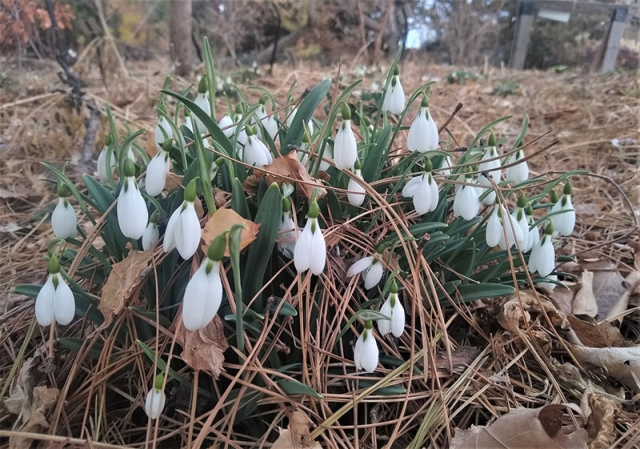Snowdrop Alert!
With this halcyon* spring-like weather, it would be a shame not to let you know that the first of this year’s outdoor floral spectacles is quietly taking place under our noses, so to speak!
Not many people would believe you if you told them that thousands of delicate white flowers have been blooming cheerfully through January outside in Denver. There are not one, but three sizeable patches of snowdrops doing just that in the Rock Alpine Garden, two of which can be accessed by the public.

The first patch was established in the 1990s from bulbs discarded from a display in Boettcher Memorial Center. They are a species of snowdrop from western Turkey (Galanthus elwesii) that invariably blooms by the end of January if planted in the right spot—and the patch of woodland to the west and north of the succulent and cactus house in the Rock Alpine Garden is just such a spot.
Curator of Alpine Collections Mike Kintgen has divided and spread these into another sizeable patch easily visible along the west end of the path that leads to the Gates Montane, just north and slightly east of the same succulent and cactus house. This one is hard to miss even if you walk quickly through the garden on a circuit of the grounds.
Best to see these in the warmth of the afternoon when they open their perianth segments (i.e. sepals) widely. Do look inside the bells—the green markings are quite intriguing; the source of endless fascination among galanthophiles!
If you are sufficiently humble, you can lean down and smell the sweet scent of the nodding flowers, which attract quite a few bees and other pollinators that would otherwise have a hard time finding some nectar this time of year.

Snowdrops are primarily found in Greece, Turkey and the Caucasus (Georgia, Armenia and Russia). I brought back seed of eight species on the expedition I was on that went to Georgia in 2018. There are several dozen species—quite a few of which are now in our collections, some starting to bloom in October and November—and most not coming out until February and March.
Quite a cult of enthusiastic gardeners pursues these plants, of which hundreds (maybe thousands) of variants have been selected. England and the Atlantic seaboard of the U.S. are the hotbeds of “Galanthophilia”—a real phenomenon, I kid you not. They have frequent gatherings and sales this time of year when weather permits.
Enjoy our halcyon moment! Now perhaps you, too, will become a galanthophile.

*Halcyon is defined as “a mythical bird said by ancient Greek writers to breed in a nest floating at sea at the winter solstice, charming the wind and waves into calm.” Since I’ve become something of an Ancient Greek, it’s only appropriate for me to use this word, don’t you agree? I’m not the first to use it for these mild days in midwinter.
 English
English Български
Български 简体中文
简体中文 繁體中文
繁體中文 Français
Français Deutsch
Deutsch Italiano
Italiano 日本語
日本語 한국어
한국어 Polski
Polski Português
Português Română
Română Русский
Русский Español
Español Tiếng Việt
Tiếng Việt Монгол
Монгол Afsoomaali
Afsoomaali
Add new comment